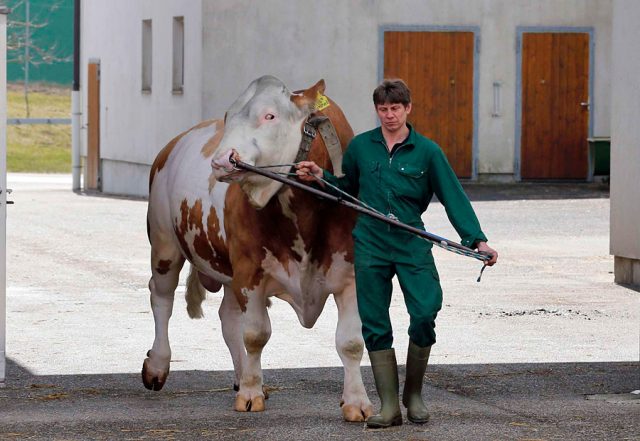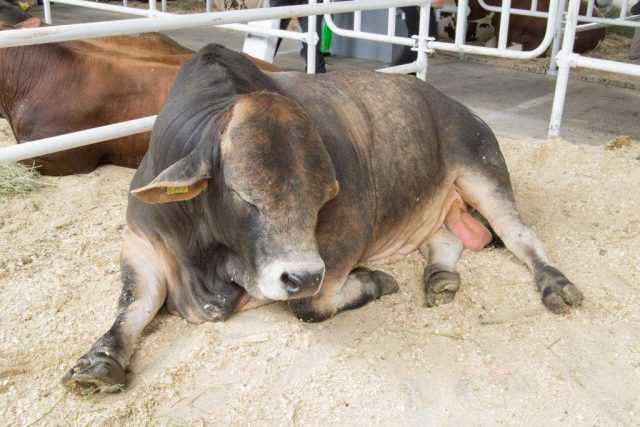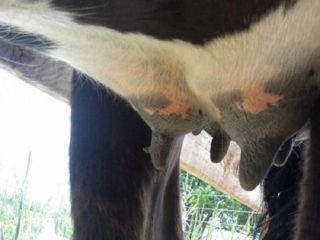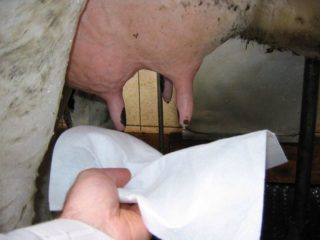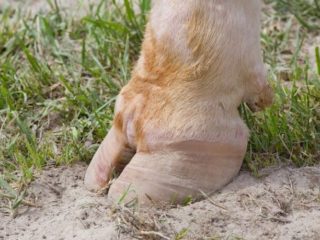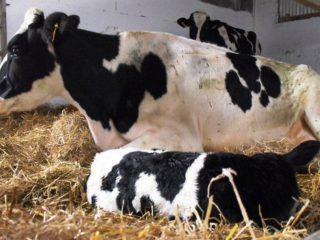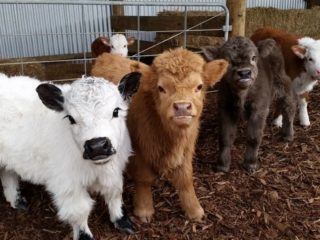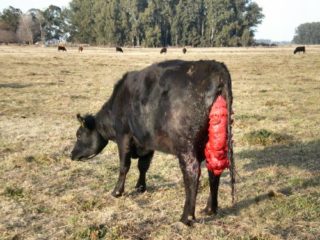Content
When breeding cattle, it is important to take into account that the right choice of animals plays a special role. The health and performance level of young animals will depend on the selected genetic material. That is why there is a certain number of criteria that must be met by an inseminating bull taking part in breeding work.
How is the selection of inseminating bulls
As practice shows, the inseminating goby is the largest animal in the herd. It is important to understand that not every bull can become a sire; they approach its selection as responsibly and carefully as possible. As a rule, only those bulls are selected whose parents had unique characteristics. The mother's milk production is assessed, and the father's reproductive ability. Also, each breed must correspond to a certain exterior. For this, the inseminating bull is measured:
- chest;
- pelvic bones;
- limbs;
- curved dorsal line;
- frame.
In the future bull-inseminator, the genitals and the quality of the semen are assessed. After collecting the semen, a series of tests are performed to determine the activity of the sperm. Active cells should be from 75% and more, while they should move in the same direction. The mother's udder, the shape and volume of the mammary glands, and the location of the nipples are assessed.
After all the necessary checks have been carried out, the plant issues a special card for the inseminating bull. In this card, you must indicate the following data of the parents:
- personal number;
- nicknames;
- distinctive characteristics of father and mother.
In addition, information on the development of the inseminating bull itself and all its offspring is further noted in the card. In addition to accounting for hereditary data, the performance of the daughters of the inseminating bull is checked. Milk signs are taken as a basis:
- take into account the number of milk yields in different lactation periods;
- milk yield for the entire lactation period;
- studies of fat content and specific gravity of proteins;
- control milking is carried out as an assessment.
In the card of an inseminating bull, the number of his daughters and the highest productive indicators are indicated. If there are record holders in the breed, then this gives the father additional advantages. The following information about the breeding bull is entered into the breeding card:
- the nickname of the bull;
- personal number by which he can be identified;
- the place where you were born;
- indicate weight at the time of birth and upon reaching: 6 months, 10 months, 1 year, 1.5 years;
- size at birth;
- describe the conditions in which the bull was;
- the diet of the animal until the moment when it was chosen as a producer.
The first signs of puberty in an inseminating bull begin to be noticeable when the bull reaches 10 months of age. When the year is reached, the inseminating bull is started to be used. As a rule, about 5-6 females are assigned to each inseminating bull, or semen is collected. During the season, up to 35 cages can be carried out with free mating. Up to 200 cages can be carried out per year.
If semen is taken, then it is further stored in ampoules filled with nitrogen. After thawing, the sperm activity is checked. Thus, about 20,000 cows can be inseminated throughout the year.
Rules for keeping and caring for animals
If you create suitable housing conditions for the inseminating bull, you can increase the reproductive capacity and significantly improve the health of the animal. The process of caring for a breeding bull-inseminator includes the following mandatory items:
- every day, the bull inseminator must be washed or cleaned using a brush. Particular attention should be paid to the head during the washing process and thoroughly wash the back of the head, forehead and the place between the horns. If these procedures are not followed, then the inseminating bull may develop serious skin problems;
- carry out regular hoof care. To avoid possible injury, the hooves of the bovine inseminator should be trimmed regularly;
- the bull's scrotum should be washed periodically with warm water. Such manipulations allow you to keep the genitals of the bull inseminator clean and healthy, as a result of which the mating process will be more fruitful;
- walk the bull every day, giving it a decent amount of time. For inseminating bulls, physical activity is extremely important, because this is how you can maintain the tone of the animal, strengthen health, the immune system, and prevent excess weight. The walk of the inseminating bull should take 3 hours or more. The area used for walking the bull should not be less than 10 acres.
To strengthen muscle tissue, you can use insemination bulls to transport various goods. In addition, it is necessary to pay special attention to the place where it is planned to keep the inseminating bull:
- bright lighting;
- suitable temperature regime;
- each inseminating bull must be in a separate stall and tied with a chain. It is important to take into account that the chain must be of sufficient length, which will allow the inseminating bull to easily move around the stall and lie down without hindrance;
- full ventilation system;
- in the stall, it is not allowed to find objects and elements about which the bull inseminator can damage itself.
If the stall for the inseminating bull is located deep in the barn, then it is necessary to provide a sufficient number of shelters along the route of the manufacturer. This is necessary so that the workers caring for the animals could, if necessary, hide at the time of the manifestation of aggression in the inseminating bull.
For the convenience of the bulls-inseminators, special strong rings are installed in the nose, which are later used as a retainer when walking the bulls.
Diet
The reproduction of the herd in most cases depends not only on the sexual activity of the inseminating bull, but also on the quality diet. It is important to consider that the diet of inseminating bulls is significantly different from that of a cow. In this case, it is necessary to take into account how often the inseminating bull is used for cage, its age, physique, and weight indicators.
For inseminating bulls, there is a certain daily routine, which is not recommended to be violated:
- 00 h. - the first meal of the bull;
- 00-07.00 h. - the bull inseminator is resting;
- 00 h. - caring for inseminating bulls: clean the wool, trim hooves if necessary, wash the scrotum;
- 00-10.00 h. - the time allocated for walking, mating or physical work on the farm;
- 00 h. - second meal;
- 00-16.00 h. - the bull inseminator is resting;
- 00-19.00 h. - farm work or mating;
- 00-21.00 h. - the third meal.
An inseminating bull weighing about 1 ton should receive about 1.5 kg of feed for every 100 kg of live weight. The diet must be complete and varied, include not only vitamins, but also minerals with proteins. For each unit of feed, as a rule, there are:
- protein - 150 g;
- calcium - 8 g;
- phosphorus - 10 g;
- salt - 10 g.
In addition, animal feed must be included in the diet of the inseminating bull, which will significantly increase the libido and the quality of the semen. If silage and hay are used in the ration of an inseminating bull, then such feed must meet all quality requirements and be of the 1st class. For hay harvesting, it is recommended to use cereals that were mowed at the time of earing, if these are legumes, then at the flowering stage. Of the cereals, it is best to use:
- timothy;
- foxtail;
- fescue;
- bluegrass.
After mowing, the hay should lie no more than a month, have a green color and have a pleasant fresh aroma. You can also use root crops, but it is necessary to give them to inseminating bulls carefully and in small quantities, since they contain nitrates that are harmful to animal health.
Approximately half of the diet of an inseminating bull should consist of compound feed, which, in turn, includes:
- oats;
- wheat;
- barley;
- wheat bran;
- yeast, salt and reverse.
In the process of feeding, it is recommended to adhere to a certain routine. For example, during the day it is necessary to feed the inseminating bull 2/3 of the total daily food, the rest is divided into morning and evening meals.
Mating methods
Today, there are 3 methods of mating inseminating bulls, which differ greatly from each other not only in terms of productivity, but also in terms of costs.
Natural insemination while walking an inseminating bull. In this case, the inseminating bull is walked together with the cows, and he covers them at the time of the hunt. The disadvantage of this method is the fact that the process cannot be controlled by a person. Among the advantages, it is worth noting a high level of probability of insemination by a bull. This method is still practiced by small farms.
Machine method. The bull carries out this insemination process in a specially prepared room in which the machine is installed. After the cow has been fed, and 2-3 hours have passed, she is brought in and fixed in this machine. The bull is allowed some time to prepare, after which, under the supervision of the farm worker, the cage is carried out. The disadvantage of this method is the high level of stress on the bull. It doesn't matter what age he is, even the largest and strongest inseminating bull is not able to cover more than 300 cows throughout the year. The bull needs special care and extended rest.
Artificial insemination of cows. This method was developed back in the days of the USSR and today it is used to carry out about 85% of all inseminations. As a rule, this method is used by large farms, but gradually small enterprises are also beginning to use it.
Using the natural method of insemination of cows leads to the fact that one has to face some problems - closely related crossing occurs, as a result of which the performance of the herd becomes much worse. This method forces farms to replace inseminating bulls every 2 years. Considering the high cost of animals, this leads to high costs.
While artificial insemination is popular, farmers may also face some challenges. For example, the percentage of successful fertilization of cows, even in the best scenario, is about 50%, as a result of which it is necessary to purchase additional doses of semen.
Conclusion
The bull inseminator plays an important role in the breeding of cattle. That is why it is necessary not only to choose the right animal, but also to provide it with a full-fledged diet.If the inseminating bull is in poor health and does not receive the necessary nutrients for the full functioning of the body, the offspring from it will be just as weak. Even if, at first glance, the offspring seem to be strong and healthy, due to the low quality of the seed, it is impossible to get a highly productive animal. In the future, this will affect the quality of the finished product.

